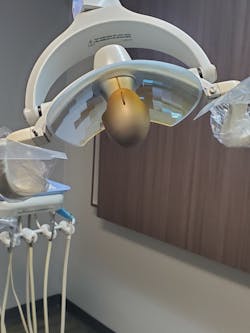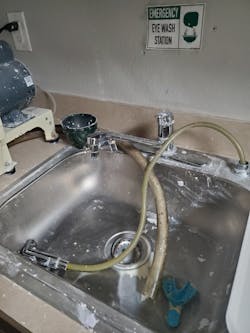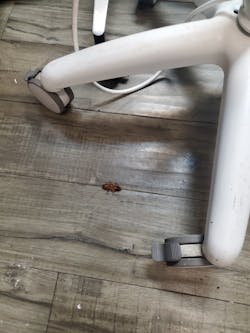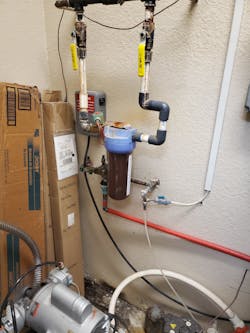Graphic OSHA violations: Don’t let this happen to you!
Editor’s note: It’s hard to believe that in today’s environment there are still dental offices that do not adhere to OSHA and CDC guidelines. The photos at the end of this article should make readers sick. Dr. Davis offers some eye-opening examples of what a few of our peers are doing, what has happened when employees report an office, and some guidance regarding what offices should be doing to meet OSHA standards, without even having to think about it! But instead, there are those trying to cut corners, eliminate extra steps, or worse yet, ignore the current climate altogether.
DOL takes OSHA dental violations seriously
The US Department of Labor (DOL) issued a press release on July 15, 2021, discussing its legal action against two North Texas dentists and their dental practice.1 An assistant and hygienist were allegedly not reinstated to employment by the dentists after a mandated clinic closure brought about when the two employees voiced their concerns about potential inadequacies with COVID-19 safety measures in the office.
The DOL release stated, “While furloughed, the two employees asked what safety measures would be in place when patients and employees returned. After receiving a call to return to work, the employers did not reinstate the hygienist after the person cited guidance from the Centers for Disease Control and Prevention (CDC) and Occupational Safety and Health Administration (OSHA).2 The dental assistant was contacted for rehiring, but the employer rescinded the offer after the assistant inquired about what safety measures would be in place for everyone’s protection.”
This action by DOL is more focused on protections for whistleblowers than any specific alleged workplace safety violations. Dallas OSHA regional administrator Eric S. Harbin stated, “This dental office violated employees’ rights by terminating them for reporting concerns about working conditions. Workers should not fear losing their jobs because they raise safety concerns within the workplace. The Labor Department will continue to vigorously enforce these protections.”
Dallas Regional Solicitor of Labor John Rainwater said, “Employees have the right to raise valid health and safety concerns, especially those related to coronavirus, and are protected by law against retaliation by employers.”
Dental OSHA training experts
Dental practice owners and dental support organizations would be well-advised to initiate OSHA compliance programs for their clinics. Annual expenses for good faith efforts toward compliance are miniscule compared to a major violation expense, especially one to cover up a violation and stifle potential whistleblowers. Costs of a serious violation may include fines and penalties, legal fees, loss of reputation, additional charges before a state regulatory board, staff turnover, and loss of patients. One’s liability insurance may or may not cover such claims.
Karson L. Carpenter, DDS, a practicing dentist and president of Compliance Training Partners, said, “In my opinion, training for OSHA and infection control should be provided by a third party, with verification in the form of a post-test and certificate of completion. Cost for training should be less than $50 per year per employee, which would include continuing education credits.”
Linda Harvey, MS, RDH, is a risk management strategist with the Linda Harvey Group and the Dental Compliance Institute. “There are a number of OSHA standards that apply to dental practices, such as the blood-borne pathogens (BBP), hazard communication, ionizing radiation, and means of egress and fire safety, to name a few," she said. "While teams may receive training on these topics throughout the year, it’s the BBP training requirements that everyone focuses on the most because they are spelled out so succinctly in this standard (see OSHA citations below). The four most common training solutions include taking CE as a team, hiring a compliance consultant, or conducting the training themselves. Large group practices usually have their own online learning platform tailored for their teams.
“The costs vary widely, from free online sources to customized onsite options,” Harvey continued. “The practice philosophy, goals, and budget typically guide their compliance decisions. Practices that seek a deeper understanding and a more personalized compliance program may add compliance to their budget. In addition, OSHA expects the team to be trained in their office-specific policies and procedures. For example, even if a team attends a CE course, it’s wise to review office-specific policies and procedures and document such review.”
Relevant OSHA citations
1910.1030(g)(2)(iv): Annual training for all employees shall be provided within one year of their previous training.
1910.1030(g)(2)(v): Employers shall provide additional training when changes such as modification of tasks or procedures or institution of new tasks or procedures affect the employee's occupational exposure. The additional training may be limited to addressing the new exposures created.
1910.1030(g)(2)(vi): Material appropriate in content and vocabulary to educational level, literacy, and language of employees shall be used.
1910.1030(g)(2)(vii): The training program shall contain at a minimum the following elements:
1910.1030(g)(2)(vii)(A): An accessible copy of the regulatory text of this standard and an explanation of its contents.
1910.1030(g)(2)(vii)(B): A general explanation of the epidemiology and symptoms of bloodborne diseases.
1910.1030(g)(2)(vii)(C): An explanation of the modes of transmission of bloodborne pathogens.
1910.1030(g)(2)(vii)(D): An explanation of the employer's exposure control plan and the means by which the employee can obtain a copy of the written plan.
1910.1030(g)(2)(vii)(E): An explanation of the appropriate methods for recognizing tasks and other activities that may involve exposure to blood and other potentially infectious materials.
1910.1030(g)(2)(vii)(F): An explanation of the use and limitations of methods that will prevent or reduce exposure, including appropriate engineering controls, work practices, and personal protective equipment.
1910.1030(g)(2)(vii)(G): Information on the types, proper use, location, removal, handling, decontamination, and disposal of personal protective equipment.
1910.1030(g)(2)(vii)(H): An explanation of the basis for selection of personal protective equipment.
1910.1030(g)(2)(vii)(I): Information on the hepatitis B vaccine, including information on its efficacy, safety, method of administration, the benefits of being vaccinated, and that the vaccine and vaccination will be offered free of charge.
1910.1030(g)(2)(vii)(J): Information on the appropriate actions to take and persons to contact in an emergency involving blood or other potentially infectious materials.
1910.1030(g)(2)(vii)(K): An explanation of the procedure to follow if an exposure incident occurs, including the method of reporting the incident and the medical follow-up that will be made available.
1910.1030(g)(2)(vii)(L): Information on the post-exposure evaluation and follow-up that the employer is required to provide for the employee following an exposure incident.
1910.1030(g)(2)(vii)(M): An explanation of the signs and labels and/or color coding required by paragraph (g)(1); and
1910.1030(g)(2)(vii)(N): An opportunity for interactive questions and answers with the person conducting the training session.
1910.1030(g)(2)(viii): The person conducting the training shall be knowledgeable in the subject matter covered by the elements contained in.
OSHA as risk management
MaryLou Austin, MS, MBA, RDH, is an instructional designer for MyDentalCE. Austin highlighted how OSHA rules are intended to protect personnel on the jobsite, but additionally protect patients and ancillary workers, such as cleaning crews and maintenance and repair people.
“OSHA annual training is a federal requirement to protect employees from injury or disease,” she said. “By extension, the concept of a ‘safety culture’ for employees also protects patients and the general welfare of the public. Not only is OSHA employee training the law, after seeing the messes that some offices get into over failure to comply, OSHA training is also risk management, which I tell nearly every dentist and manager I speak with about OSHA training.”
Austin commented on the source of OSHA complaints and costs involved with defense. “Most OSHA citation reports come from disgruntled employees or upset patients. This occurs for a variety of reasons, but if there is no evidence of an adequate OSHA compliance attempt and annual OSHA (and HIPAA, health and human services, and sexual harassment prevention) training, defending a citation can be expensive, difficult, and disruptive for a practice.
“OSHA training can be done very inexpensively or can be prohibitively expensive, especially if using some consultants or large dental companies,” she continued. “If an office is a laggard and not in compliance at all, their state dental association is likely the best place to start, which is the advice I give dentists and offices facing a low compliance situation. Many state associations offer free or inexpensive customizable OSHA manuals, sometimes particular to their state. The California Dental Association is great about assisting dentists to be compliant, and the information is built into their practice resources website.”
Author’s note: The American Dental Association offers the Complete OSHA Compliance Kit at a reasonable price and is substantially discounted for members.
COVID-19 costs
The overhead expense per patient for one dentist and one assistant can easily climb to more than $20 per patient visit, just for expensing of personal protective equipment (PPE) and routine infection control protocols.3 These costs escalated drastically during the pandemic, especially prior to vaccinations. Additional operational expenses may have included air filtration or air modification systems, added protective shields or barriers, ultraviolet light disinfection, social distancing of patients in reception rooms, and longer appointment times.
In concert with elevated dental clinic operational overhead were government-mandated facility closures. Expenses increased while production was cut. In the majority of cases, dental insurance and dental Medicaid fee schedules were frozen, and no offsetting charge for PPE or infection control could be passed to the consumer.
Numbers of dental practices felt the financial squeeze. Since meeting OSHA and CDC standards could not generate production revenue or elevate EBITDA numbers in hopes of a private equity roll-over, less ethical dental businesses started to cut corners.
Here I share photos taken during this era of COVID-19 in a dental clinic whose ownership felt forced to take shortcuts in infection control and OSHA to control costs.
Conclusion
The lesson of the DOL filing a legal action against the practice in North Texas is similar to the stories of Watergate or Enron. Legal history is replete with stories of people or companies turning a manageable legal problem into a serious one by trying to hide or destroy evidence. Workplace discrimination against a potential OSHA whistleblower is a far more damaging issue than any alleged specific site violations.
1. OSHA News Release - Region 6. United States Department of Labor. July 15, 2021. https://www.osha.gov/news/newsreleases/region6/07152021
2. OSHA update: Despite 'gray areas' of new COVID-19 protection standard, most dental offices to remain exempt. DentistryIQ. June 25, 2021.
3. Disposable infection control item costs. Clinicians Report Foundation. April 21, 2020. https://www.cliniciansreport.org/uploads/files/1877/PPE-costs-per-patient.pdf
About the Author
Michael W. Davis, DDS
Michael W. Davis, DDS, maintains a general dentistry practice in Santa Fe, New Mexico. He chairs his district dental society peer review committee and is involved in state dental association issues. He is also active with consultation and expert witness work for a variety of attorneys. Dr. Davis may be reached at [email protected] or on his website, smilesofsantafe.com.






